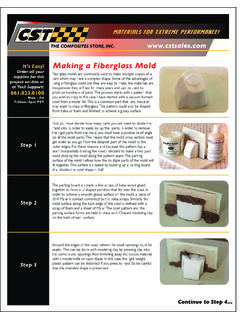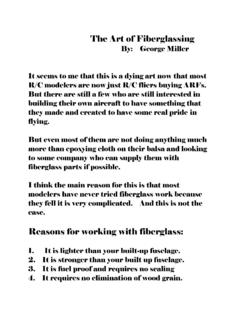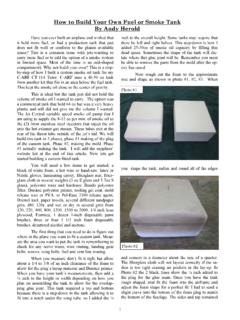Transcription of Preparing plaster of Paris for mould making Materials
1 Preparing plaster of Paris for mould making Materials : A 10-pound sack of plaster of Paris A large wash basin A large metal soup spoon Note: The proper mixing of plaster of Paris is of the utmost importance. It is the essence of successful mould making . If the plaster is improperly made, the plaster may harden too rapidly, may flake, or may form air bubbles on its surface. Follow the procedure below exactly and carefully. Procedure: Fill the wash basin about half full of water and set on a level surface. With the hand, lift out powdered plaster of Paris from the sack or container. With a gentle sprinkling motion, sifting the powder between the fingers, permit the powder to fall evenly all over the surface of the water. With the thumb rubbing across the fingers break up any lumps of powder, and let the particles fall between the fingers. Add powder in this fashion until the water is completely filled.
2 Add more powder until it just appears in a dry state above the surface of the water, indicating that the water is fully saturated with powder. Do not disturb the water, nor stir the powder in the water during this sifting process. Permit the powder to remain undisturbed in the water for 2 minutes. Now with the spoon, stir the mixture very thoroughly but slowly from the bottom up and around, to release any air bubbles which may have formed in the water. Stir evenly but not too quickly, until the mixture begins to thicken. The plaster is ready to be used. It now may be poured or spooned around the model. See the next two parts of this lesson on applying plaster of Paris . After all the required plaster has been used, the plaster remaining in the wash basin should be washed out into a large container. This container should be emptied on the ground outside; never in the drain. It will quickly stop up the drain pipes.
3 If the plaster hardens in the wash basin, it may be broken away and the scrap pieces thrown away. They cannot be used again. making a two-piece mould Materials : Same as lesson VII, plus: 1 flexible steel palette knife 4 pieces of Plexiglas or other plastic nonporous sheet, 1/8 inch or 1/4 inch thick (for size see note below) 5 pounds plastic clay, any colour, well wedged 1 heavy lead pencil 1 strong teaspoon 1 simple glazed model, hole in the base (see text below) Comments: This lesson indicates the principles to be observed in making a two-piece mould . These principles are applicable to the making of any multi-piece mould . Fig 30 We shall select a ceramic duck as a model, as being a simple item with which to begin. Any simple model may be used. The model selected should have a smooth glazed surface with a hole in the bottom. "In the trade," moulds comprising actually three pieces, in which two of the pieces contain the cavity, and a third or bottom piece contains the gate and forms the base of the casting, are often called two-piece moulds .
4 The pieces of Plexiglas will be used to form a hollow box, in which the plaster mould will be formed. Measure the length, width, and height of the model. The pieces of Plexiglas should be larger by 2 inches on each dimension than those of the model, so that there will be a thickness of at least 1 inch of plaster at all points. Procedure: Lay the model (duck) on its side. Look down upon it from directly overhead. Your eye should be at least 2 feet above the centre of the model. Note the outermost edges or outline of the duck which is visible to your eye. With a pencil, mark this outline on the duck (Fig. 30A). This pencil line will be the dividing line where the two parts of the mould , which will be formed around the duck, come together. This dividing line is in effect the outline of the silhouette of the duck. On the duck, the dividing line will run from the front point of the base, up the centre of the duck's chest and neck, divide the bill in two, run across the top of the head, down the back of the neck, across the centre of the back, along the outermost edge of the tail feathers, down the centre of the lower rear of the duck, to the base again.
5 Now study each side of the duck, divided by the line. There must be no undercut surfaces on either side. If there are undercuts, it will be impossible to remove the model from the mould without damage. The surfaces of the model must curve or fall away on either side of the dividing line. This line does not have to be straight, nor does it necessarily divide the model into two equal parts. In fact, if a model is not absolutely symmetrical (exactly equal and identical on both sides) the dividing line will never be straight throughout. Stand the duck erect on its base on the table. Now, cover up one side of the duck right up to the dividing line with plastic clay. Do not place any clay on the bottom of the base. Do not cover the dividing line with the clay. Build up the clay until it stands out from the line at least 1 inch and until it forms a block 2 1/2 inches deep, 8 1/2 inches long, and 7 1/2 inches wide with the duck buried in it up to the dividing line.
6 (These dimensions are 1 inch larger in each direction than this particular duck) (Fig. 30B). Lay the block of clay on a side with the duck uppermost. Trim the clay with the palette knife so as to form a smooth clay shoulder out from the model, horizontally and following the dividing line (Fig. 30B). Place the pieces of Plexiglas around the block of clay. The base of the duck should be flat against one Plexiglas side. Secure the pieces of Plexiglas against the clay block by tying twine around the outside. Fill in the inside corners of the box formed by the Plexiglas with plastic clay, to even the level of the shoulders. Apply a soap film all over the exposed part of the model and the clay shoulder. Now prepare a pan of plaster of Paris , as indicated in lesson VIII. Spoon plaster into the corners of the open Plexiglas box, and on top of the model (Fig. 30C). Pour plaster into the Plexiglas box until the model is buried to a depth of 1 inch above the highest part of the model.
7 Level the top of the plaster with the paint scraper. Let the plaster set. Fig 31 After the plaster hardens, remove the Plexiglas sides. Turn the block of plaster and clay upside down so that the plaster rests on the bottom. Peel away all the plastic clay. Examine the model and shoulders of plaster . The plaster should follow the dividing line exactly. Trim the shoulder of plaster to a smooth surface with a pen knife (Fig. 31A). Fill in any holes in the plaster with soft plaster . The model may be removed from the plaster . Do not dig out the model; tap it out. The shoulder should be gently sandpapered to smoothness. Do not sandpaper the shoulder so that it drops below the level of the dividing line of the model. Replace the model in the plaster indentation. Note: The first time you make a two-piece mould , you may have some doubt as to where the dividing line should be located exactly. Assume that the line lies more toward the side which you are covering with plastic clay.
8 This will result in more plaster , to be formed on the opposite side-perhaps beyond the depth where the dividing line should be. After the plaster sets and the clay is peeled off, try to tap out the model. If It fails to come out, you can cut or trim back the plaster shoulder with a pen knife until the model does come out. The second plaster half can be then formed against the first half as indicated below. Remember that you can always cut or trim back the plaster , but you cannot add on plaster if you failed to form enough at first. Thus, it is better to overlap the first piece of plaster and cut it back the proper amount. With the spoon tip, dig out four key holes in the plaster shoulder, by twisting the spoon back and forth in a circular motion at each point (Fig. 31A). Clean the surface of the model and plaster shoulder of any remaining bits of clay, with a stiff hair brush. Now, apply a heavy soap film to the model, all over the plaster shoulder, and in the key holes.
9 This soap film is a separator between the two parts of the mould . Secure the Plexiglas sides around the plaster block again with twine. Spoon and pour plaster of Paris into the space formed by the Plexiglas box above the model, to a depth of at least 1 inch above the highest part of the model (Fig. 31B). Smooth the top surface with the paint scraper. Let the plaster set. Fig 32 After the second piece of the plaster mould has hardened, remove the Plexiglas sides. Secure the two pieces of plaster together by tying twine around them. Turn the assembly so that the base of the model faces up. With the knife and sandpaper, smooth the top surface of the two pieces of plaster , keeping them as level as possible. With the teaspoon tip, cut two keyholes in each plaster piece (Fig. 32A). Observe the hole in the base of the duck. Carve a piece of wood, in the shape of a tapered cork, so that it will fit exactly in the hole and taper outward, and extend at least 1 1/2 inches above the top of the hole.
10 With the tip of the knife, pack plastic clay between the wooden plug and hole, so that no plaster can run in between the wooden plug and the wall of the hole in the model (Fig. 32B). Apply a heavy soap film to the top of the plaster pieces, the key holes, the base of the model, and the wooden plug. With the spoon, apply plaster to the top of the plaster pieces, and build it up to a depth of at least 1 inch. Plexiglas sides can be extended from the sides of the two plaster pieces, and the plaster spooned and poured in the hollow box so formed, instead of building up the plaster manually, if desired. Let the plaster set (Fig. 32C). Now with the penknife and sandpaper, round all outside edges and corners of the plaster pieces. Remove the top plaster piece. Remove the wooden plug by tapping with the hammer, if necessary. Slightly round the topside edge of the gate left by the removal of the plug.









